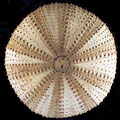The Echinoid Directory
Pseudoboletia Troschel, 1869, p. 96
| Diagnostic Features |
|
|---|---|
| Distribution | Recent; Indo-Pacific and Caribbean. |
| Name gender | feminine |
| Type | Pseudoboletia stenostoma Troschel, 1869 [=Toxopneustes indianus Michelin, 1862], by original designation. |
| Species Included |
|
| Classification and/or Status |
|
| Remarks |
|



